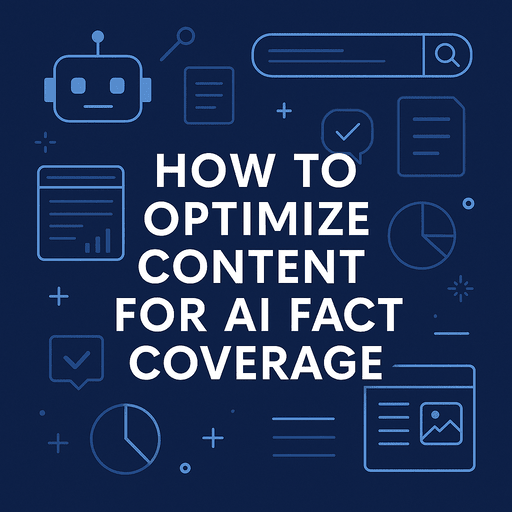How to Optimize Content for AI Fact Coverage

Short Answer: To optimize content for AI fact coverage, include complete, verifiable details like statistics, dimensions, and entity connections so AI engines can cite your page in AI Overviews.
Introduction
Imagine a driver in San Diego searching for the 2026 Mazda3. They’re not typing “Mazda3 dimensions” anymore. Instead, they ask Google, “Does the new Mazda3 have more trunk space than last year’s model?”
In seconds, an AI Overview appears with a neatly packaged summary: the exact length, width, height, and cargo capacity. If your content doesn’t provide those details, your page isn’t even considered. It’s invisible, skipped over in favor of the source that covered the facts in full.
This is the reality of search in 2025. Nearly 47% of Google searches now display an AI Overview, and click-through rates drop by 20–40% when those summaries appear. To stand a chance, you need more than keywords. You need fact coverage.
Learning how to optimize content for AI fact coverage is no longer optional. It’s the difference between being a cited authority or being erased from the conversation.
What Is Fact Coverage in AI SEO?
Fact coverage is the depth and breadth of factual details your content provides. Instead of asking, “Did I use the keyword enough?”, the real question is, “Did I cover every relevant fact?”
Examples of strong fact coverage include:
-
A Honda CR-V review that lists every dimension, from cargo space to ground clearance.
-
A honey product page that names the floral source, antioxidant profile, and health studies.
-
A healthcare article that cites real statistics, expert opinions, and recognized entities.
And the demand for accuracy is rising. Research shows that only about 51.5% of AI-generated sentences are fully supported by citations, and just 74.5% of those citations actually back the statement. That means your content has a better chance of being trusted by AI when it is factually complete and verifiable.
Why Fact Coverage Matters for Google AI Overviews
AI Overviews are trained to compress knowledge into a clean, trustworthy snapshot. They do not care about filler words. They scan for facts, entities, and verified details they can stitch together into an answer.
Here’s why it matters:
-
Visibility: The more factually complete your content is, the higher the chance AI includes it. Nearly half of all searches now present an Overview.
-
Trust: Content with stats and citations feeds directly into E-E-A-T signals.
-
Stickiness: Readers linger when the answers are specific, not fluffy.
And the stakes are high. Organic CTR drops by 20–40% when AI Overviews appear in results. If you are not fact-rich enough to get cited, your visibility could shrink fast.
How to Optimize Content for AI Fact Coverage
Want your content to land in an Overview? Stop chasing phrases and start feeding the machine what it needs.
Here’s how to optimize content for AI fact coverage:
-
Include statistics and verified sources. Instead of saying “AI SEO is growing,” anchor it with studies such as 65% of businesses report improved SEO results from using AI.
-
Cover every angle of the topic. Anticipate what readers and AI will ask, and answer it before they search again.
-
Tie entities to the knowledge graph. Name brands, places, and people so your content syncs with recognized entities.
-
Add structured data. Schema tells AI, “This fact is real, here’s how to parse it.”
The more complete your coverage, the more irresistible you become to the algorithms pulling answers.
Fact Coverage vs Keyword Coverage: What’s Changing
Keyword coverage was once the golden rule. Repeat the phrase, sprinkle synonyms, build links, and you were done.
That era is over.
-
Old SEO: “Say it often enough and Google will listen.”
-
New AI SEO: “Prove it, structure it, and leave no fact behind.”
This shift is not cosmetic, it is existential. Keywords open the door, but facts decide whether you get invited inside.
Practical Example: Fact Coverage in Action
Take two posts about Mazda3 dimensions.
-
Post A: “The 2026 Mazda3 has a roomy interior and good trunk space.”
-
Post B: “The 2026 Mazda3 Sedan is 183.5 inches long and 70.7 inches wide, with 13.2 cubic feet of trunk space. The Hatchback version measures 175.6 inches in length with up to 20.1 cubic feet of cargo space.”
Which one gets cited in an AI Overview? Post B, because it offers numbers, specifics, and facts that cannot be disputed.
FAQ
What is fact coverage SEO?
It is the practice of optimizing content to include the full set of statistics, numbers, and entities AI needs to summarize your page accurately.
Does fact coverage improve AI Overview visibility?
Yes. AI favors content that is factually rich and complete, making it more likely to appear in Overviews.
How do I know if my content has enough fact coverage?
Audit your content. Compare against competitors, SERPs, and knowledge panels. If there are facts they have and you do not, you are not fully optimized.
Conclusion: The Future of Fact Coverage in AI SEO
The next era of SEO is not built on clever phrasing, it is built on facts. If you master how to optimize content for AI fact coverage, you will position yourself not just to rank, but to be quoted, cited, and trusted by the very AI engines shaping the future of search.
The brands that invest in completeness will rise. The ones that do not will fade into the white noise of forgotten web pages.
If you want your content to appear in AI Overviews and be trusted as a source, I can help. Contact me today to create fact-rich, AI-optimized content that gets cited instead of ignored.

0 Comments Add a Comment?